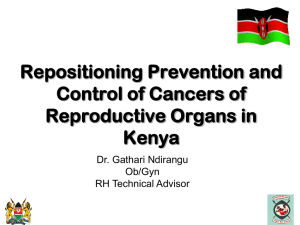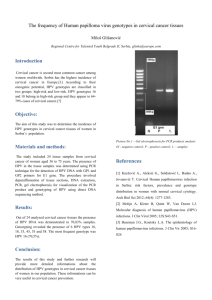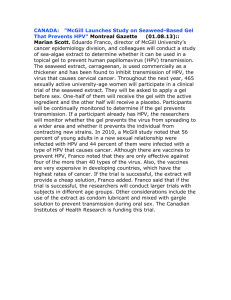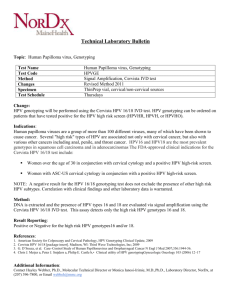Prevalence of Human papilloma Virus DNA In HIV
advertisement
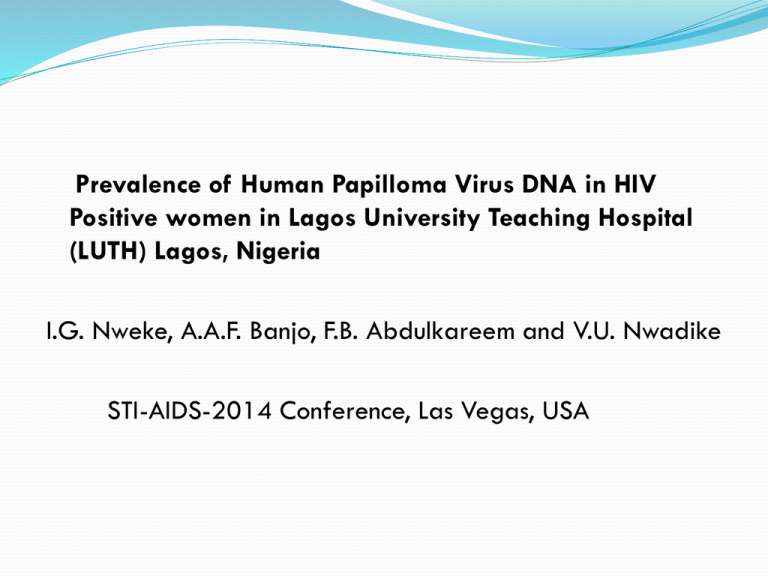
Prevalence of Human Papilloma Virus DNA in HIV Positive women in Lagos University Teaching Hospital (LUTH) Lagos, Nigeria I.G. Nweke, A.A.F. Banjo, F.B. Abdulkareem and V.U. Nwadike STI-AIDS-2014 Conference, Las Vegas, USA Introduction Persistent infections with high risk human Papilloma virus (HPV) is a well established cause of cervical cancer In Nigeria 23.7% of women harbour cervical HPV infection at any given point in time HIV positive women are more frequently infected with multiple HPV types due to their impaired immune status Introduction HIV positive women with severe immunosuppression are 5 times more likely to have lower genital tract neoplasia Treatment failure and recurrence are also more common among them This necessitates routine screening for genital tract neoplasia and cancer among this group of women. Aim of the study To determine the prevalence of genital human papilloma virus infection among HIV positive women at LUTH Lagos, Nigeria Relate HPV genotypes in the study population to commercially available HPV vaccine types Study type The study design is a comparative cross-sectional analytic observational study It was undertaken at the AIDS Prevention Initiative clinic (APIN) and the Gynecologic outpatient dept. of LUTH Ethical clearance was obtained from the ethical committee of LUTH Duration of study was between August 2011-August 2012. Study Population Comprised of 100 HIV positive women within the reproductive age group attending APIN clinic The control group comprised of 100 HIV negative women coming for routine cervical cancer screening test. Sampling Technique Systematic random sampling technique was used to select the study subjects. Average of 300 HIV positive women are bled every 2 weeks at the APIN clinic for CD4 counts and viral load estimations Sampling interval : total population (300)/sample size (100) was set at 3 Similar sampling technique was applied in the selection of the control subjects Eligibility/Exclusion criteria Consenting HIV positive women 18 years and above who were recently bled for CD4 counts and viral load estimations Consenting HIV negative women 18 years and above. Those who were excluded were : Females who were menstruating Those who were pregnant Those who have had hysterectomies performed on them. Those who declined HIV testing. HPV test collection Cervical samples were collected with disposable specimen collection kits (Hybribio Biochemical company Ltd. China) Stored at -20˚C at the Anatomic and Molecular Pathology dept. of the CMUL, Lagos, Nigeria. All paticipants had VIA (visual inspection with acetic acid) performed on them Those with abnormal findings on VIA were referred to the Gynecology department of LUTH free of charge for colposcopy and when necessary biopsy and treatment. HPV Serotyping Samples were screened for HPV infections using HPV Genoarray test kits (Hybribio Biochemical Company Ltd. China) Kits use a combination of both polymerase chain reaction (PCR) and flow through hybridization technology Twenty-one types of HPV DNA in cervical samples are genotyped qualitatively using this kit HPV types 6, 11, 42, 43, 44, 16, 18, 31, 33, 35, 39, 45, 51, 52, 56, 58, 59, 66, 68, 53 and CP8304 HPV Serotyping This process involved : DNA extraction PCR amplification Flow-through hybridization Result interpretation DNA extraction Aliquots of cervical samples were repeatedly centrifuged at 14,000 rounds per min. for 3 times each lasting 5 mins After each centrifuge, supernatant was discarded and buffer solutions added respectively to the remaining suspension DNA was extracted by the lysis of cells, isolation, precipitation and purification 1 ml of sample was then pipetted for PCR amplification PCR amplification All PCR reagents were spun for 5 minutes PCR mastermix solution was prepared by mixing appropriate quantities of PCR-mix solution and DNA Taq polymerase for each reaction tube. One microlitre of DNA template was added to each PCR tube The solution was centrifuged for a few seconds Subsequently placed in a thermal cycler for DNA amplification The primer used was MY09/11 primer system Flow-through Hybridization The PCR products were denatured at 95˚C for 5mins The HybriMem HPV-21 DNA microarray membrane marked with 21 HPV genotype probes was put in place The PCR products and the prewarmed hybridization solution were mixed together and then added into sample wells It was thereafter incubated for 20 mins and blocking solution added The membrane was washed with hybridization solution and enzyme conjugate added to display the result. Result interpretation Solution membranes were dried on absorbent paper A positive result was indicated by a clearly visible indigo dot The HPV genotype result was determined according to the position of specific probes on the HybriMem HPV-21 membrane Multiple dots indicated multiple infections Actual HPV types were determined by comparison of the position of the dots to known reference points. HPV membrane result worksheet HPV Serotyping For quality, positive and negative controls were included during the analysis Positive control was needed to demonstrate the efficiency and specificity of the PCR Negative control would indicate if the PCR reagents were contaminated To reduce contamination all equipments were sterilized by radiation before use. Data presentation and test statistics Data processing was done using Epi info version 3.5.6 and Microsoft Excel Frequency distribution was used to determine the relationship between variables The student T-test was used for comparison of mean differences The Chi-square test was used to compare the differences between proportions All statistical analysis was at 5% level of significance p≤0.05 (95% confidence level) Results Ninety-eight (98%) HIV positive and 97 (97%) HIV negative women participated in the study Mean ages of the participants were was 36.8±9.0 years and 43.8±10.5 years for the test and control groups respectively Figure 1: showing HPV distribution for the different age ranges HPV test result (HIV positive women) A total of 19 different HPV types were identified from 45 (44.90%) of the women Thirty-seven women (37.75%) were infected with the high risk types Eleven women (11.20%) had multiple HPV high risk HPV infections involving between 2 and 7 HPV types Five females (5.10%) were infected with the low risk group HPV test result (HIV positive women) Commonest high risk types detected were: Type 31 (16.80%) Type 52 (15.20%) Type 53 (9.10%) Type 35 (7.60%) Commonest low risk types detected were: Types 6 and 11 (3.0%) each Type 44 (1.5%) HPV test result (HIV positive women) Overall single genotypes were found in 27 females (27.55%) Both high and low risk genotypes were found in 4 females (4.0%) HPV test result (HIV negative women) Eleven females (11.34%) tested positive for HPV infections All HPV infections detected were of the high risk types Three females (3.0%) tested positive for multiple HPV types Commonest high risk type detected was type 18 (23.10%) followed by 16, 52 and 56 (15.40%) respectively. Figure 2: showing distribution of HPV genotypes among the respondents Discussion The prevalence of HPV in this study among HIV positive and negative women was 44.90% and 11.20% respectively This is comparable with a prevalence of 57.10% seen in HIV positive West African immigrants resident in Southern Italy (mostly Nigerians) A prevalence of 26.30% was also discovered among the general population of Ibadan, Nigeria Discussion Reasons for the increased prevalence seen in HIV positive women include: A more efficient HPV replication in immunodeficient host leading to increased detection rate, treatment failures and recurrence. There is also a higher chance of developing persistent HPV infections (arbitrarily defined as 2 or more positive HPV tests in one year) Persistence is the first step towards the development of high grade SILs and cancer Discussion Previous studies carried out in other parts Africa have shown a higher HPV prevalence depending on how the women were selected and HPV tested for: Burkina Faso (66.10%) Zambia (97.2%) This may be attributable to the exhaustive nature of the HPV detection strategy Studies have shown that by using a primer pair alone HPV types 26, 35, 42, 45, 52, 54, 55, 59, 66, 68 and 73 might be missed leading to errornously low results. Discussion The commonest high risk HPV types detected among HIV positive women were types 31, 52, 53 and 35 in decreasing order of prevalence This finding is similar to what was found in Burkina-Faso: types 52, 35 and 58 Zambia: types 53, 31, 51 and 45 But sharply contrasts with a world wide prevalence of HPV 16 and 18 and our control group This findings may have important implications: Discussion If cross immunity is not induced across viral types by existing vaccines, efficacy of existing prophylactic HPV vaccines may be limited in immunosuppressed women in these regions Among the control group high risk type 18 was the commonest followed by 16, 52 and 56 This is not unusual since the behavioral and socioeconomic characteristics of HIV infected women may differ from the normal population Discusssion The incidence of multiple HPV types among the HIV positive women (11%) This is similar to the incidence discovered in a cohort of HIV positive women in the US (12%) Much lower than 45% and 78.6% seen in Brazillian and Zambian HIV positive women Variability in the genotype method used may account for these differences Discussion Older women 25-34yrs age range were more likely to be infected with high risk HPVs unlike <25yrs and >55yrs This is also similar to what was discovered in HIV positive Rwandan women May be due to the time taken for persistence to dev in those 25-34 yrs and the decreased sexual activity seen in those >55yrs Discussion HIV negative women 45-54 yrs had 2 folds increased risk of having high risk HPV than 25-34yrs. Similar to what was discovered in the general population of Ibadan, Nigeria A fraction of the spouses of these women may continue to have multiple sexual partners thereby reinfecting themselves and these women. Conclusion Due to the high prevalence and diversity of HPV genotypes found in the HIV positive women, There should be adequate protocols for cervical cancer screening in this group of women Bilateral and Multilateral donor programmes in developing countries should be linked to cervical cancer screening strategies among these women Studies should also be carried out to determine the efficacy of existent HPV vaccines on this group of patients Co- authors Banjo A A F Professor of Anatomic Pathology. College of Medicine, University of Lagos, Nigeria. Abdulkareem F B Professor of Anatomic Pathology. College of Medicine, University of Lagos, Nigeria Nwadike V U Consultant Microbiologist, Federal Medical Centre Abeokuta, Ogun state. Acknowledgements I wish to thank the conference organizers for the opportunity given to me to present this topic And you all my audience for your rapt attention THANK YOU ALL ONCE MORE References Bosch FX, Lorinz A, Munoz N, Meijer CJL, Shah KV. The casual relation between Human papilloma virus and cervical cancer. J Clin Pathol 2002;55(4):244-65. Franco EL, Harper DM. Vaccination against Human papilloma virus infection: a new paradigm in cervical cancer control. Vaccine. 2005;23:2388-94. WHO/ICO HPV information centre on HPV and cervical cancer (HPV information centre). Human papilloma viruss and related cancers in Nigeria. Summary report 2010. Available: www.who.int/hpvcentre. Coutlee F, Rouleau D, Ferenzy A, Franco E. The laboratory diagnosis of genital Human papilloma virus infections. Can J Infect Dis. 2005;16(2):3391. Moore RA, Ogilvie G, Fornika D, Moravan V, Brisson M, Amirabbas-Beik M, et al. Relevance and type distribution of Human papilloma virus in 5000 British Columbia women-implication for vaccination. Cancer Causes Control. 2009;20(8):1387-96 References Sahasrabuddhe VV, Mwanahamuntu MH, Vermund SH, Huh WK, Lyon MD, Stringer JSA et al. Prevalence and distribution of HPV genotypes among HIV infected women in Zambia. Br J Cancer. 2007;96(9):1480-83. Firnhaber C, Zungu K, Levin S, Michelow P, Montaner LJ, M acPhail P, et al. Diverse and high prevalence of Human papilloma virus associated with a significant high rate of cervical dysplasia in human immunodeficiency virus women in Johannesburg, South Africa. Acta Cytol. 2009;53(1):10-17. Moodley JR, Constant D, Hoffman M, Salimo A, Allan B, Rybicki E, et al. Human papilloma virus prevalence, viral load and precancerous lesions of the cervix in women initiating highly active antiretroviral therapy in South Africa: a cross-sectional study. BMC Cancer. 2009;9:275-282 Ferenzy A, Coutlee F, Franco E, Hankins C. Human papilloma virus and HIV co-infection and the risk of neoplasias of the lower genital tract: a review of recent developments. CMAJ. 2003;169(5):431-34. Stier E. Human papilloma virus related diseases in HIV infected individuals. Curr Opin Oncol. 2008;20(5):541-6. References Bratcher LF, Sahasrabuddhe VV. The impact of antiretroviral therapy on HPV and cervical intraepithelial neoplasia: current evidence and directions for future research. Infect. Agent Cancer. 2010;5:8-20. Tornesello ML, Duraturo ML, Buonaguro L, Vallefuoco G, Picolli R, Palmieri S, et al. Prevalence of Human papilloma virus genotypes and their variants in high risk West African women immigrants in South Italy. Infect Agent Cancer. 2007;2:1-9. Thomas JO, Herrero R, Omigbodun AA, Ojemakinde A, Ajayi IO, Fawole A, et al. Prevalence of papilloma virus infection in women in Ibadan, Nigeria: a populationbased study. Br J Cancer. 2004;90(3):638-645. Levi JE, Kleter B, Quint WGV, Fink MCS, Canto CLM, Matsubara R, et al. High prevalence of Human papilloma virus (HPV) infections and high frequency of multiple HPV genotypes in human immunodeficiency virus infected women in Brazil. J Clin Microbiol. 2002;40(9):3341-5. Didelot-Rousseau MN, Nagot N, Costes-Maritineau V, Valles X, Ouedraogo A, Konate I, et al. Human papilloma virus genotype distribution and cervical squamous intraepithelial lesions among high risk women with and without HIV-1 infection in Burkina Faso. B J Cancer. 2006;95(3):355-62. References Sanjose S, Quint WGV, Alemany L, Geraets DT, Klaustermeier JE, Lloveras B, et al. Human papilloma virus genotype attribution in invasive cervical cancer: a retrospective cross-sectional worldwide study. Lancet Oncol, 2010;11:1048-56. Ellerbrock TV, Chiasson MA, Bush TJ, Sun XW, Sawo D, Brundney K, et al. Incidence of cervical squamous intraepithelial lesion in HIV infected women. JAMA 2000;283:1031-7. Gonclaves MAG, Massad E, Burratini MN, Villa L. Relationship between Human papilloma virus (HPV) genotyping and genital neoplasia in HIV positive patients of Santos City, Sao Paulo, Brazil. Int J AIDS. 1999;10:803-7. Singh DK, Anastos K, Hoover DR, Burk RD, Shi Q, Ngendahayo L, et al. Human papilloma virus infection and cervical cytology in HIV infected and HIV uninfected Rwandan women. J Infect. Dis. 2009;199(12):1851-61. Keita N, Clifford GM, Koulibaly M, Douno K, Kabba I, et al. HPV infection in women with and without cervical cancer in Conakry, Guinea. Br J Cancer. 2009;101(1):2028.



